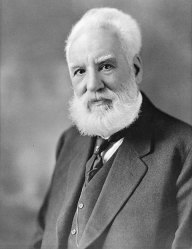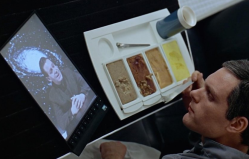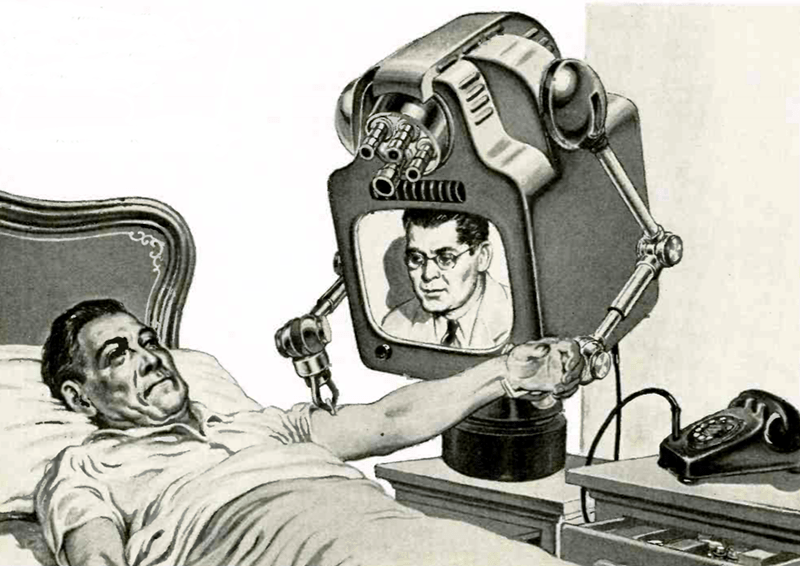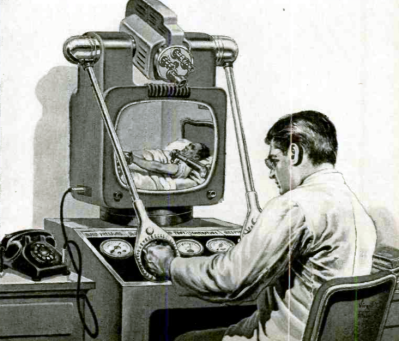Few occupations are more fraught with peril than predicting the future. If you are a science fiction author, it might not matter, but if you are trying to design the next game-changing piece of hardware, the stakes are higher.
It seems like, for the most part, even if you manage to get some of the ideas right, the form is often way off. Case in point: telemedicine. Today you can visit a doctor using video conferencing with your phone or a PC for many common maladies. A new idea? Not really. Hugo Gernsback wrote about it in Radio Electronics back in 1955.
Gernsback wrote:
The average medical doctor today is overworked and short-lived. There are never enough doctors anywhere for the world’s constantly multiplying population. Many patients die because the doctor cannot reach them in time, particularly at night and in remote regions.
…[H]e can only see a few [patients] during the day. With increasing traffic congestion, many doctors refuse to make personal calls — execept in emergencies. Even then they arrive often too late. Much of this dilemma will be archaic in the near future, thanks to the Teledoctor.
Gernsback envisioned a doctor using what we now call Waldos similar to what people use to manipulate radioactive material. These super mechanical hands (Gernsback’s words) would allow the doctor to write a prescription, pour liquids, or even diaper a baby thanks to a sense of touch built into them.
Oddly enough, Gernsback’s vision included renting a teledoctor from the drugstore for $3.50 a day. This way, the doctor could call on you and then follow up as well. The drug store would deliver the machine and it would — get this — connect to your phone:
A cord with the a telephone plug attached to the teledoctor instrument is now plugged into a special jack on your telephone. Future telephones will be provided with this facility. The TV signals and telehand electronic signals, etc., will all travel over the closed circuit telephone lines.
In a footnote, Gernsback notes that you can’t send a 525-line TV signal on current phone lines, but a 250-350 line picture was possible and that would be sufficient.
Visionary? In some ways, maybe. The basic idea is coming true today, although it isn’t likely doctors will do surgery or inject you remotely in your home anytime soon. The special telephone plug sort of came true and is already obsolete. The images, by the way, are the ones that accompanied the original article in Radio Electronics.
Other Predictions
 It seems like many new things are written off as fads by the establishment: cars, electricity, TV, smartphones, and telephones were all considered untenable by someone famous enough to matter. For example, apparently, Alexander Grahm Bell offered Western Union’s president the phone patent for $100,000 (a lot of money in 1876). The president’s internal memo on the subject reportedly said, “The idea is idiotic on the face of it. [W]hy would any person want to use this ungainly and impractical device when he can send a messenger to the telegraph office and have a clear written message sent to any large city in the United States.” Why indeed.
It seems like many new things are written off as fads by the establishment: cars, electricity, TV, smartphones, and telephones were all considered untenable by someone famous enough to matter. For example, apparently, Alexander Grahm Bell offered Western Union’s president the phone patent for $100,000 (a lot of money in 1876). The president’s internal memo on the subject reportedly said, “The idea is idiotic on the face of it. [W]hy would any person want to use this ungainly and impractical device when he can send a messenger to the telegraph office and have a clear written message sent to any large city in the United States.” Why indeed.
 On the other hand, Edward Bellamy, a science fiction author, predicted the debit card (and universal income) in 1888. Robert Boyle (the chemist who understood how gasses worked) predicted organ transplantation in the late 1600s. If you look closely at 2001: A Space Odyssey, you’ll see them using what amounts to a tablet computer to read the news and letters from home. Watching it today, it seems completely unremarkable.
On the other hand, Edward Bellamy, a science fiction author, predicted the debit card (and universal income) in 1888. Robert Boyle (the chemist who understood how gasses worked) predicted organ transplantation in the late 1600s. If you look closely at 2001: A Space Odyssey, you’ll see them using what amounts to a tablet computer to read the news and letters from home. Watching it today, it seems completely unremarkable.
However, for the most part, predictions are hit and miss. Even 2001: A Space Odyssey predicted moonbases and shuttles by 2001, which didn’t happen. The video below focuses on fashion for the year 2000 — as it seemed in the year 1939. Most of the predictions are a miss, but we did enjoy the very unusual looking man at the end wearing a phone and a radio.
The Last Few Decades
If you look back over the last few years, what would have surprised you before you saw it? A 32-bit computer with built-in WiFi for a few dollars? Speech recognition that works well enough to be a consumer item? How many things were called big hits that were really fads (say, the Segway) and how many fads were really big hits (cameras on cell phones)? Now look forward to the next 20 years. It is hard to imagine.
We’ve looked at bad predictions in the movies. We’ve also pondered the fate of the smoking robot from the 1930s.

















“In a footnote, Gernsback notes that you can’t send a 525-line TV signal on current phone lines, but a 250-350 line picture was possible and that would be sufficient.”
We’ve been spoiled. 4K or nothing.
“However, for the most part, predictions are hit and miss. Even 2001: A Space Odyssey predicted moonbases and shuttles by 2001, which didn’t happen.”
If we hadn’t lost our will we might have.
Slow scan tv has been around since about 1957. But oddly, early fax machines had some level of compatibility, the big difference being fax used paper, sstv used a long persisgence CRT for display.
So I suspect by the time of this Gernsback prediction, the tele screen was feasible, just not for showing motion since the screen updated too s!owly.
When a prediction is made matters a !ot. Ear!y it means more than later, since later yku have more advanced techniques to imagine a future.
People say Heinlein predicted cellphones but really in the juveniles he predicted mobile phones, not really a stretch. Thkugh in one of the early books or novellas, not a juvenile, he at least says something about some isdurs to overcome before portable pho es are feasible. I think “Beyond this Horizon”.
Ot course, Gernsback was also “predicting” “gee this would be great” things rather than just extrapolating from “now” to the future. So yiu can generate a !ot of predictions, but onky some come close to hitting. It looks better when the misses are forgotten, only leaving the hits.
Michael
The video phone was developed by AT&T in the 1950s.
CCTV videophones were used way back in 1936 between several post offices in Germany.
> The video phone was developed by AT&T in the 1950s.
And by British Telecom in the 1990s. It has always amused me how this much-anticipated invention was not actually very popular when it hit the market (although I see that they are still available in the UK market).
> Heinlein predicted cellphones
Whether or not he did, apparently he predicted
> what we now call Waldos
Bear in mind that the video recording then would have been live, whereas these days there’s so much latency and delay that the 4K picture lags by half a second.
The video codec needs to buffer many frames in order for the compression to work properly, so you get a choice between “calling to the moon” even between neighbors, 1and the image breaking up and skipping constantly.
It used to be that you could play “Hugo” by phone via a live TV camera in the studio, where people would press dial tones to play a honest to goodness reaction game and win prizes. This is no longer possible. There is no live TV anymore.
Gernsback also wrote Ralph124C41+ in serial form in 1909. He edited a number of magazines that appealed to the experimenter. He also helped us win World War 2 by encouraging farm boys (and a few girls) to lift their gaze from the hog pens up to the stars by encouraging their inventiveness.
A Logic Named Joe” is a science fiction short story by Murray Leinster, first published in 1946. The story is particularly noteworthy as a prediction of massively networked personal computers and their drawbacks, written at a time when computing was in its infancy.
Read that story recently, and its prediction of the internet is uncanny. Especially in 1946.
I think we should differentiate between things we don’t have due to insufficient scientific progress and things we don’t have because humanity decided to prioritize other things.
I’m not quite sure to what category moon bases belong to.
It’s amazing that we actually have rockets that can reach orbit and then land tail-down on legs – it’s basically exactly what people were predicting in the 50s and 60s. I’ve watched ~20 SpaceX launch + landings, and every time I see it happen I still think “That will never work!”
“It’s amazing that we actually have rockets that can reach orbit and then land tail-down on legs – it’s basically exactly what people were predicting in the 50s and 60s.”
Our version of Planet Express Ship.
https://theinfosphere.org/Planet_Express_ship
I remember what a friend of mine said the first time SpaceX managed a successful landing:-
“Rockets landing on their tails, as God & Heinlein intended!”
It’s hard to explain how amazing it was to an old Boomer like me, who read Asimov, Clarke, etc., growing up, to see a SpaceX ship landing on it’s tail, as God and Heinlein intended. I work at NASA and all of us here were cheering as we watched.
Well, a part of the ship.
It’s not quite Thunderbirds, and it never will be because it’s physically impossible with all known fuels – unless you construct a rocket of ungodly proportions to lift a tiny payload. The rocket equation is a harsh mistress.
And thank you James Williams for working to help keep the dream alive. And you’re not the only one who does that, and largely from the same period as yourself. Heck! I followed all of the later launches, and watched and wondered about them. Now? SpaceX does what RAH intended.
Remote surgery is becoming a thing now, btw. It doesn’t happen in the home, but apparently useful when a specialist is on one coast, and the patient is on the other.
there’s just the problem with having to purchase and maintain the ~$2M surgical robot… no idea on how much the remote operator console costs…
While Gernsback may have described a remote-operated mechanical hand and arm in 1955, he was just building on an already-established (fictional) technology and term. Mr. Williams refers to this device as a “Waldo”; that term is derived from the fictional “Waldo F. Jones’ Synchronous Reduplicating Pantograph” described in Robert Heinlein’s 1942 short story “Waldo”.
Heinlein described it in 1942. Later engineers developed the physical devices, and named them “Waldo”s in reference to the Heinlein description. And, Hugo Gernsback, both an SF publisher and a “futurist”, ran with the idea.
I almost included that but decided it was long enough.
“ …whenever a baby is born anywhere in the world, he is given at birth a… telephone number for life [and]… a watch-like device with ten little buttons on one side and a screen on the other…. when he wishes to talk with anyone in the world, he will pull out the device and [call] his friend. Then turning the device over, he will hear the voice of his friend and see his face on the screen, in color and in three dimensions. If he does not see and hear him he will know that the friend is dead. ”
—Harold Osborne, 1948
Not entirely wrong: cell phone numbers aren’t assigned at birth, but they *are* tied to a person rather than a location, and tend to follow a person for life. You can even take your call on a wristwatch these days. I don’t like his nightmare world where people *have to* answer every phone call they get, though!
“although it isn’t likely doctors will do surgery or inject you remotely in your home anytime soon”, well maybe not surgery but injections, why not, house calls used to be a common thing, but are now almost unheard of, but if you deliver a telepresence machine to a home (by amazon drone) and the doctor can examine and treat you at home (especially if your are old and the doctor is busy, common things today) why shouldn’t it happen?
“the doctor is busy”… give me a break, doing what counting his money. I look forward to the day these scammers are put out of business by AIs…
More are being approved, whether they’re personalized medicine valid and the most optimal diagnostic and therapeutic method is another issue and concern:
https://1712507217.rsc.cdn77.org/wp-content/uploads/2019/06/0606_FDA_infographic-copy.png
Valid Healthcare and Public Safety that is Lean Sigma Legal would be awesome… I am pessimistic regarding in my generation even though is feasible.
What a really stupid comment.
Why don’t you grow up ?
1) a certified surgical robot is stupidly expensive
2) even if you made it smaller and cheaper, all the certification and maintenance requirements would still make it very expensive, not something you want to try and deliver by a flimzy drone
3) physics are a thing, if you want the telepresence robot to be of any use, it has to be heavy, otherwise it would not be capable of doing things like holding out a patients arm or leg…heavy means unsuitable for drone delivery…
You should look at the shortage of doctors in Northern Canada, even if the docbot had to be delivered in a truck by someone it would still be a great help.
But once it got there, will it have a suitably fast network connection to be useful?
Technically, the future can be something like “Lasers, The Light Fantastic” or even earlier works similarly titled “Lasers, A Light Fantastic,” where real time scanning halograph/tomography systems using intersecting beams to ablate, cauterize or even tweeze to move into position (cells even) and hold for cauterizing/ablating and even coagulating. The closest I’ve seen are the gamma and cyber knives.
My thoughts have mainly been concerns with degassing and making sure vascular systems were constricted and the correct system dilated, so to degas otherwise some sort of micro vents would have to be ablated in to prevent embolisms. Thrombosis can be ablated or even vibrated when identified. Thus, a minimalist approach to morbid surgery would be needed for robotic or human intervention to perform task. Basically, advancing Minimally Invasive Surgery.
Leave the critical operations processes to the highly critically validated software and hardware systems that performs the non-invasive surgery and I guess in time… the more morbid invasive surgeries. The only limiting factor is the implementation of the logic by ones that don’t want the more logical system operation.
some of the doctors that service a nearby nursing home are so good they can treat their patients from the staff staion with out even seeing the patient. – The charge reflects there “expertise”
The progress of computer technology has been amazing and leaving behind even the keenest predictions. The progress of space flight, however… it’s the ultimate disappointment in comparison. At least to my childhood self it feels like the hoverboard we never got, still being stuck with big smelly rockets that have to come apart halfway into space, which I’ll never get to fly to the moon in… while all the really cool “impossible” computer stuff basically became true times a hundred and I can hold it in my hands today.
Robotics is somewhere inbetween I guess. ;-)
My ideas are thermonuclear power plants that are external combustion or use thermal vents in higher pressure environments and those power plants being better buffered and more modularized as well as easier to maintain and decommission.
https://share-ng.sandia.gov/news/resources/news_releases/new-suncatcher-power-system-unveiled-at-national-solar-thermal-test-facility-july-7-2009/
NASA has data somewhere online in a research paper that I am not finding now that I wanted to reference.
I think improvements to remove parasitic losses in general though say for latency for more real time signals processing up to theoretical limits and then improvements somehow. Drive trains for vehicles will be more direct and improvements will be made to keep up the business of maintenance for wheel hub motors/generators.
https://spectrum.ieee.org/transportation/advanced-cars/protean-electrics-inwheel-motors-could-make-evs-more-efficient
More solar concentrating operations and in particular foundries, kilns and other high temperature manufacturing operations… especially in more hostile temperature environments and adding consideration for lossssses (maybe place in a greenhouse).
https://www.mont-louis.net/english/heritage/solar-furnace/
https://www.youtube.com/watch?v=0tK3s1Vnol0
http://discovermagazine.com/2010/sep/solar-concentrator-reaches-5000-degrees
Seems the future is going to be human body sensors for diagnostics, boundary sensors and perimeter sensors for health and safety risks. I’m sure this will be the future anywhere we are in the new “Space Shield” or whatever the Electromagnetic Spectrum situation is… of course which will require a Crime Enforcement Division where would be candidates can get caught and have their sentences/convictions set aside to become a government slave.
Like I noted also before on Hackaday; Faraday Cage Anechoic Chamber Room, or House, options for Residential Home Owners builds will be more standard and known… same is going to happen for the vehicles. Most won’t realize more than the house and vehicle will be able to perform diagnostics and therapeutics.
Typo: “…thermonuclear power plants that are external combustion or use thermal vents in higher pressure environments…”
Equals: “…thermonuclear power plants that use external combustion generators/alternators, or thermal vent powered external combustion generators/alternators, that take advantage of higher pressure environments.
Oh, while I have this article in my thoughts more regularly… I’ve wondering about aircraft carriers that can always stay aloft. I envisioned this (and have commented online years ago regarding) I think first to try to figure a way to change the atmosphere of Venus and first off having to settle with satellites or stations high in altitude so to take advantage of the gravity and atmospheric conditions that are more favorable. Then that morphed into… why not try up in the earth’s atmosphere.
I figured something that can mine gases, like hydrogen…, then realized that’s no way going to work and a drone style systems with six or more motors, redundant controls and redundant nuclear power plants to drive the electric motors so to be able to perform maintenance on the craft with seamless replacing, like a “hot swaps,” of the controls and power train. Then something that is a hovercraft aircraft carrier seems like can be feasible.
I mean… like… seems so feasible, I’m surprised no one has attempted or even written about regarding. Then again, what’s the need for? I guess I thought as what is finally moving forward from my childhood visions of using drones and spacecraft launches from aircraft I grew up reading about methods used in the 1950’s.
Another system that is interesting is the inspired by roller coaster rides electromagnetic linear accelerators/brakes or most know as rail gun systems more-so. Since a child I thought those would be another good idea for launching planes since steam seems like a great idea also (especially if surface area of the planet is a concern along with fuel costs) and why not use for launching spacecraft and more aircraft?
I also have this vision of larger electronics related storage systems using more toxic materials in more sealed environments so the material can be put to use better with a design of the system taking into account recycling of the materials to be re-used and not so much decommissioned only. Of course consideration will be for upgrading and improvements. However, seems the higher security clearance sites can make use of the more toxic materials and keep those materials away from the masses and still be utilized for operations in safer and healthier ways.
More tunnel boring might be a thing too. I’m thinking more surface area can be used to naturally produce survival requirements raw materials, intermediates and finished products… especially the higher surface area plants like trees. Get more of the polluting systems underground and in closed loop operations to better process the waste and if venting then vent through high rises. More high rise buildings can create developments above ground that limit the surface area footprint and make better use of the volume. With the high rise buildings integrating more outdoor natural ecosystems from the range of natural resources to domesticated farm and crop resources. Including yards and forests inside. I’m surprised a colleges forestry department hasn’t proposed such forest high rise. Seems disturbing I’ve never read this anywhere. Same goes with agriculture colleges other than the more modern vertical gardening methods indoors.
Finally, seems the use of nuclear isomers, transition elements, isotopes of elements and the most challenging from what I envision is the nucleogenesis of waste materials into more valuable healthy practical materials. Stabilizing the isotopes will be an interesting operation to master like other electronics systems where lower energy methods might be available and no one has considered the bang for the buck.
I think all the above with solar concentrating powered production systems in the most thermally hostile parts of the World. Seems like it’s dry out there also, so less energy needed for drying when not monsoon season.
Wondering about boring more tunnels underground and as I noted above… though for more underground roadways might be something that will be happening. I didn’t realize what the Boring Company has done compared to what I last looked at while at Tech like with the English Channel.
“Even 2001: A Space Odyssey predicted moonbases and shuttles by 2001, which didn’t happen.”
It also showed the Bell System and mentioned the Soviet Union…
In response to AKA the A.
You nailed it!
In fact, that scene in 2001 was used by Samsung as evidence of prior art in one of the lawsuits with Apple concerning iPad patents.
I sort of predicted Internet e-commerce in 1989 as a college student.
I was taking a digital telecom course and the final exam was to make a proposal for a retail payment processing network. The course at that time had been taught with the language of leased point-to-point lines from Ma Bell, but I had heard of the CiX and that Sprint had a deal whereby if you’d just get a line from your facility to the nearest SPRINT PoP, you could effectively use the CiX as the interconnect for free. I wrote my proposal up using that as the basic architecture and came up with a figure about 10% the cost that everyone else in the class came up with. The prof accepted it for full marks and remarked that he was going to have to take a hard look at the course content, as things they were a-changin’.
I wish I had saved a copy of that proposal. :)
Rocket assisted landing which you’d think can be controlled now days with thrust vectoring to hover land safely from high altitude with avionics to control optimal flight pattern based on system time and resources or even when emergency braking for aborting take-offs for safe landings after distance exceeded in runway or even after take off… only got this far:
https://www.military.com/video/aircraft/military-aircraft/top-secret-c-130-with-rocket-boosters/912500478001